In her strong legs and the bare, vulnerable feet; in a long, deep gash on her back; in the upright posture and gaze; and in the sight of the two large jugs she is carrying are the visual reality that children lived as slaves in the United States. This statue is sure to inspire many stories and conversations about what this young girl lived through and triumphed over. The newly unveiled sculpture of Sojourner Truth as the child Isabella, in the Hudson Valley village of Port Ewen, will speak to generations about aspects of slavery in America that do not get enough attention.
The sculpture is likely to generate a greater focus on a woman who rose from her difficult beginnings as a slave to become one of the most prominent activists for freedom in American history. On Sept. 21, 2013, the Town of Esopus unveiled the sculpture of Truth in a ceremony that drew some 200 people. The unveiling capped an ambitious, painstaking initiative of several years by a group of Ulster County residents.
The striking sculpture is believed to be the only statue in the United States to show a slave child at work. It sits in an attractive corner plaza, a tiny place of peace amid many village storefronts and near the often traffic-filled intersection of Route 9W and Salem Street. The memorial doesn’t need to be huge or possess a grand promenade to portray history very powerfully. Instead, the sculpture’s life-like qualities in showing a young enslaved girl and its accessibility – on a short base that allows children to be on the same level as the sculpture – do so. Moreover, the power lies in how it documents a fact that many either do not know or neglect: Slavery existed in the North well into the 1800s.
Artist Trina Greene created the bronze sculpture, which shows Truth at about the age of 13 during the time that she was a slave whom a local man, Martinus Schryver, owned. Truth spent the first 29 years of her life as a slave in various Ulster County households, before she walked away in the pre-dawn darkness and escaped to her freedom one day in 1826. (See “Tracing Sojourner Truth’s Escape Route” on Mindfulwalker.com.) Schryver operated a tavern, and his family lived in a still-standing stone house on Route 9W just a half-mile from where the memorial is located.
The statue captures a child who is soft, vulnerable, and yet strong, not so different from many children her age. This is its power, too, an ability to bring home that slavery occurred to children who are like our children today. Truth, as the child Isabella, is a beautiful girl whose facial expression is open, serious, and perhaps pained in some way, but not defeated.
A Stolen Childhood
In her narrative and in speeches, Truth consistently cited the important, abiding influence of her mother, Elizabeth Baumfree, from whom slavery separated her at a very early age. She also pointed to her faith and determination, which she held onto all while, as she said, slave owners had robbed her of her childhood. In the sculpture, I see this girl, standing up straight as if her mother is watching her posture. She is hearty, perhaps more so because of the physical labor she had to perform hoeing in the field or carrying jugs of liquor for miles for her slaveholder. Despite her strong bearing, Isabella in this sculpture appears vulnerable and unprotected, a child who has had to make her way as an adult, away from parents and almost all of her brothers and sisters since they were sold off before she knew them.
In the realistic, dramatic rendering of Truth as a child, the statue and the accompanying memorial support the Town of Esopus’ goal of drawing greater attention to Truth’s birth and early life here. New York State Assemblyman Kevin Cahill obtained a capital grant for major funding of the statue and park, and local organizations, businesses, and individuals contributed to the effort. The unveiling came after several years of planning, meticulous research, and work by the town’s Sojourner Truth Memorial Committee, which Ulster County historian Anne Gordon leads. (For a look at the entire endeavor and more on what went into the sculpture, see “Statue To Show Sojourner Truth as a Child” on Mindfulwalker.com.) The sculpture reflects the committee’s goals and vision combined with sculptor Greene’s artistic expression.
It took much research and care to arrive at a rendering of a child for whom no photographs exist. In guiding this interpretation, the group and the sculptor relied on historical sources such as Truth’s own narrative; documentation about the clothing slaves wore; and photos of Truth in later life as well as of her descendants. The advertisements for slave auctions that slaveholders placed in newspapers were a good source, Gordon has said. Greene found an early 19th century book very helpful in fashioning the look of coarse burlap for Isabella’s clothing. Also, Greene drew on The People of Kau, German film director Leni Riefenstahl’s photographic monograph on the lives of people living in the Nuba Mountains in southern Sudan.
The features and expression of Truth’s face are sure to spark attention and discussion. What is she feeling? What does her expression say? When asked last year to describe what the statue would look like, Greene said, “There is innocence and yet knowingness on her face. This is a child whose mother talked to her about life and about faith, that all of them would reunite in heaven some day, telling her to always tell the truth, do her best, and God would answer your prayers. So she is open and sweet but with the cloud of having been whipped, having to work, and knowing the suffering of life.”
“…Who Made Your Skin White?”
In this sculpture, many will have an opportunity to appreciate the young girl who endured, despite her years of hardship and mistreatment such as beatings, and thus to understand the suffering of millions of other slaves – especially children, who remain enslaved in some parts of the world today. Ultimately, Truth overcame what biographer Nell Painter called the “soul murder of slavery” to become one of America’s foremost heroines and to speak out and advocate forcefully and courageously for freedom for African-American slaves, women’s right to vote, the abolition of capital punishment, and for opportunities for freed slaves. In this rendering, one can see a determined child before she became the tall woman who enthralled audiences with her moving oratory and wit, and who spoke with calm conviction in the face of others’ hisses and shouts.
Truth lived through a childhood in which slaveholders separated her from her parents and kin; at various times beat, abused, or neglected her; and never educated or provided for her adequately. Her experience and her belief that the Divine had called on her to preach led her to go forth and relentlessly challenge convention, as she did when she spoke to a group of children at the Sabbath School Convention in 1863 at Battle Creek, Mich.: “Children, who made your skin white? Was it not God? Who made mine black? Was it not the same God? Am I to blame, therefore, because my skin is black? Does it not cast a reproach on our Maker to despise a part of His children, because He has been pleased to give them a black skin? Indeed, children, it does; and your teachers ought to tell you so, and root up, if possible, the great sin of prejudice against color from your minds.”
Here is a further look at the sculpture of Sojourner Truth, the child Isabella.
The sculpture contains deep gashes on the back for the scars that Truth had from the beatings she sustained as a slave. In one incident that Truth later recounted, slaveholder John Neely beat her severely with heated rods.
The statue is at the center of the Sojourner Truth Memorial. A prominent sign tells of Truth’s early life and of the key places in that history.
The sculpture has very life-like attributes and shows, for example, how a slave child such as Isabella had to walk constantly outdoors in barefeet.
To Explore Sojourner Truth’s Ulster County History
In 2012, Mindfulwalker.com examined Truth’s early life in depth and published a series through which it is possible to explore this history by walking and driving to various sites.
Part 1: In Sojourner Truth’s Footsteps – Explores the Jug Tavern, where Truth lived and worked as a slave
Part 2: Tracing Sojourner Truth’s Escape Route – Visits the Sojourner Truth Memorial in Port Ewen and traces Truth’s escape route on Ulster County roads
Part 3: Statue to Show Sojourner Truth as a Child – Tells of the work to create a statue of Truth as a child and reveals the plans to make it the centerpiece of the Sojourner Truth Memorial in Esopus
In September, Mindfulwalker.com previewed the Sept. 21 ceremony:
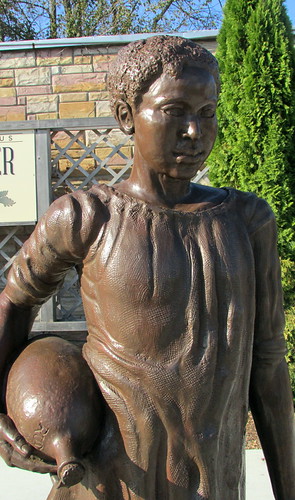
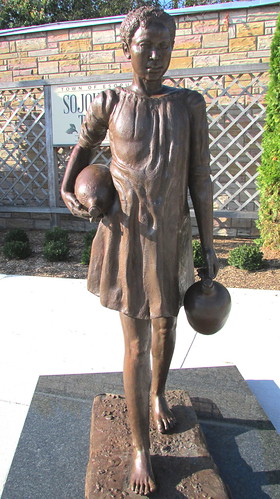
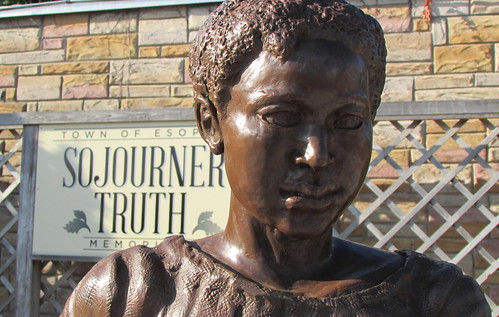
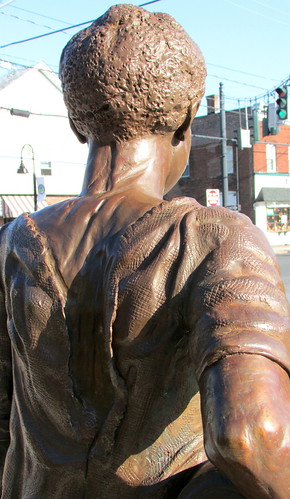

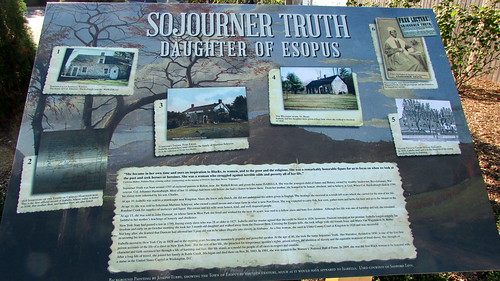

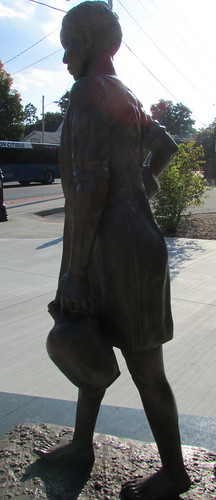
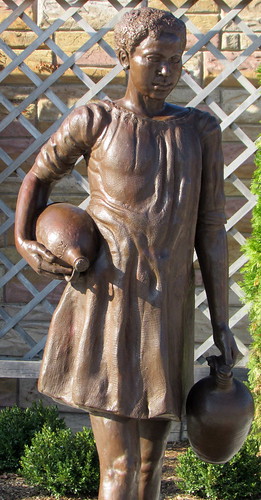



Beautiful article about Sojourner Truth. Thank you!
Thank you, Marguerite!